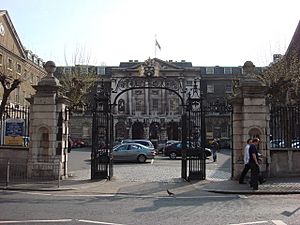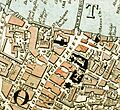Guy's Hospital facts for kids
Quick facts for kids Guy's Hospital |
|
|---|---|
| Guy's and St Thomas' NHS Foundation Trust | |

Guy's Hospital entrance with Boland House on the left and the Chapel on the right
|
|
| Lua error in Module:Location_map at line 420: attempt to index field 'wikibase' (a nil value). | |
| Geography | |
| Location | Great Maze Pond, Southwark SE1 9RT, London, England |
| Organisation | |
| Care system | NHS England |
| Hospital type | Teaching |
| Affiliated university | King's College London / KCLMS |
| Services | |
| Emergency department | No |
| Beds | 400 |
| History | |
| Founded | 1721 |
Guy's Hospital is a famous hospital in central London, England. It was started by a kind man named Thomas Guy. The hospital is part of the NHS, which provides healthcare in the UK. It is also part of Guy's and St Thomas' NHS Foundation Trust.
Guy's Hospital is a big teaching hospital. This means it helps train new doctors and nurses. It works with King's College London GKT School of Medical Education, alongside St Thomas' Hospital and King's College Hospital.
The hospital has a very tall building called the Tower Wing. When it was built in 1974, it was the tallest hospital building in the world! It stands at about 148 meters (487 feet) and has 34 floors. Even today, it is one of the tallest buildings in London. It is also one of the tallest hospital buildings in the world.
Contents
History of Guy's Hospital
Guy's Hospital began in 1721. It was founded by a generous person named Thomas Guy. He made a lot of money by printing Bibles. He also invested wisely in a company called the South Sea Company.
Thomas Guy wanted to help people who were very sick. He especially wanted to help those who could not be treated at St Thomas' Hospital. The leaders of St Thomas' Hospital supported his idea. They gave him land nearby for a very low rent for 999 years.
Thomas Guy passed away in 1724. He was buried in the hospital's chapel. His tomb has a beautiful marble sculpture by John Bacon.
The first buildings of the hospital were built in 1739. They formed a courtyard. The main buildings were designed by the King's Master Mason, John Deval.
In 1829, a man named William Hunt left a huge amount of money to the hospital. It was £180,000, which was a lot back then! This money helped the hospital add 100 more beds. A part of the hospital built in 1850 was named after William Hunt.
In 1974, the hospital added the very tall Guy's Tower. It also added Guy's House. These buildings were designed by Watkins Gray.
In 2004, a special center opened. It is called the Wolfson Centre for Age-Related Diseases. This center studies diseases that affect older people. These include conditions like Alzheimer's disease, stroke, and Parkinson's disease. The Princess Royal opened this center.
In 2005, the hospital's children's departments moved. They moved to the new Evelina London Children's Hospital. This hospital is located near St Thomas' Hospital. A new cancer center was finished in 2016. It was designed by Rogers Stirk Harbour + Partners. This new center cost £160 million to build.
Hospital Facilities
| Tower Wing | |
|---|---|

Tower Wing, after exterior refurbishment
|
|
| General information | |
| Status | Complete |
| Location | Southwark |
| Coordinates | 51°30′12″N 00°05′13″W / 51.50333°N 0.08694°W |
| Current tenants | Guy's and St Thomas' NHS Foundation Trust |
| Construction started | 1968 |
| Completed | 1974 |
| Owner | National Health Service |
| Height | 148.65 metres (487.7 ft) |
| Design and construction | |
| Architect | Watkins Gray |
Today, most medical services at Guy's Hospital are in buildings east of Great Maze Pond. These buildings are connected. They are called the Tower Wing, Bermondsey Wing, Southwark Wing, and Borough Wing. The Cancer Centre is in its own building nearby.
The Tower Wing is 148.65 meters (487 feet) tall. For a while, it was again the tallest hospital building in the world in 2014. However, a new building in Houston, USA, is now taller.
Notable People from Guy's
Many important people have worked or studied at Guy's Hospital. Here are a few of them:
- Thomas Addison, who discovered Addison's disease
- Benjamin Guy Babington, who invented the laryngoscope (a tool to look at the throat)
- Richard Bright, who discovered Bright's disease (a kidney problem)
- Sir Astley Cooper, a surgeon who found the Cooper's ligaments in the breasts
- C. S. Forester, a famous English novelist, who studied medicine here
- Abraham Pineo Gesner, a surgeon and the inventor of kerosene
- Sir William Withey Gull, who described myxoedema (a thyroid problem) and coined the term anorexia nervosa
- John Braxton Hicks, an obstetrician who discovered Braxton Hicks uterine contractions
- Thomas Hodgkin, who discovered Hodgkin's lymphoma (a type of cancer)
- Sir Frederick Hopkins, who discovered vitamins
- John Keats, a famous poet
- Emily MacManus, a Matron (head nurse)
- Humphry Osmond, a psychiatrist
- Sir Alfred Poland, who first described Poland syndrome (a birth defect)
- Keith Simpson, a forensic pathologist
- Dame Sarah Swift, a matron who helped found the Royal College of Nursing
- Ludwig Wittgenstein, a famous philosopher, who worked as a hospital porter during World War II
Hospital Symbols (Arms)
Like many old institutions, Guy's Hospital has its own special symbols, called "Arms." These were given to the hospital in 1725. They include a shield, a crest, and supporters (figures holding up the shield).
The hospital's motto is "Dare Quam Accipere." This is a Latin phrase that means "Give rather than receive." It shows the hospital's spirit of helping others.
Images for kids
See also
 In Spanish: Guy's Hospital para niños
In Spanish: Guy's Hospital para niños
- Francis Crick Institute
- Healthcare in London
- King's Health Partners
- List of hospitals in England
- Tall buildings in London








